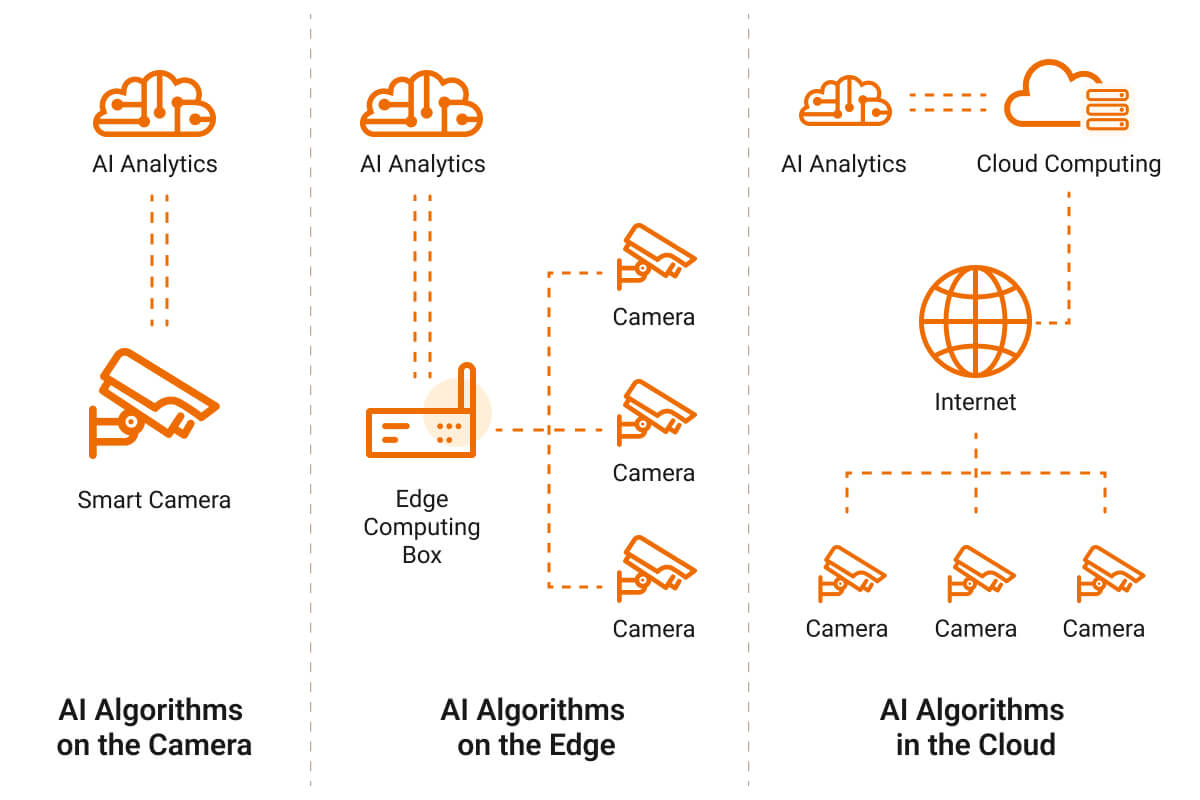While BLE AoA (Angle of Arrival) is gaining popularity as an asset and personnel positioning method, Bluetooth RSSI positioning remains a relevant and cost-effective option. AoA methods come with complex algorithmic requirement and higher costs, making them less ideal for every Bluetooth positioning scenario. This article aims to introduce Bluetooth RSSI positioning, which is more budget-friendly and user-friendly. It is well-suited for indoor BLE asset tracking applications that do not demand extremely high accuracy levels.
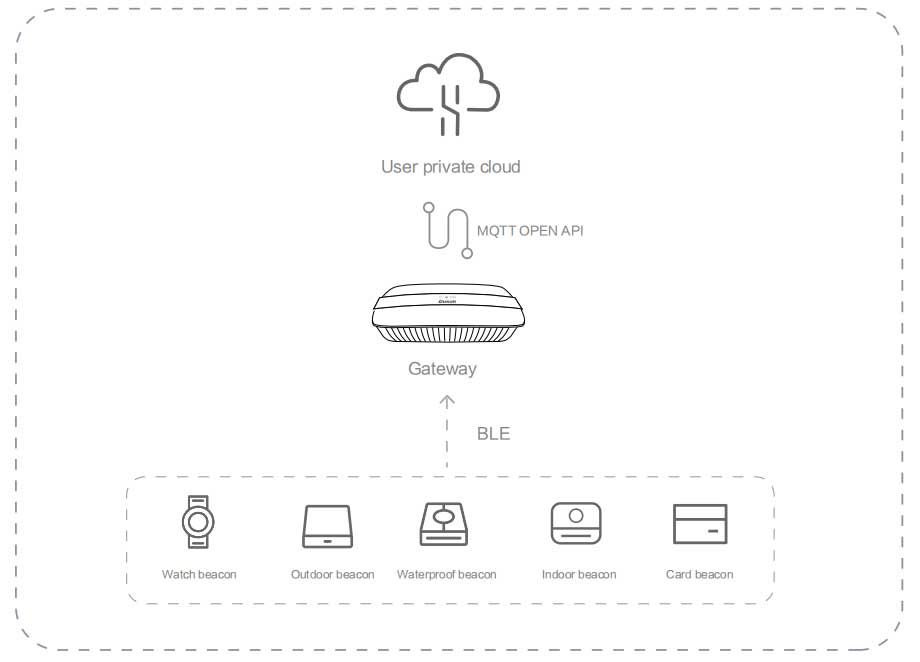
What is Bluetooth RSSI Positioning?
RSSI is the abbreviation of Received Signal Strength Indication, which represents the strength of the received signal. It assists devices in gauging the received signal’s strength and the distance between the signal source and the receiver. RSSI is also employed in various wireless communication technologies, such as LTE and Wi-Fi.
Bluetooth RSSI positioning is a technique that leverages the relationship between Bluetooth RSSI signal attenuation and distance to calculate the location of the Bluetooth terminals. Typically, Bluetooth RSSI positioning offers an accuracy of 2 to 5 meters. This BLE positioning solution is characterized by easy deployment, cost-effectiveness, and affordability.
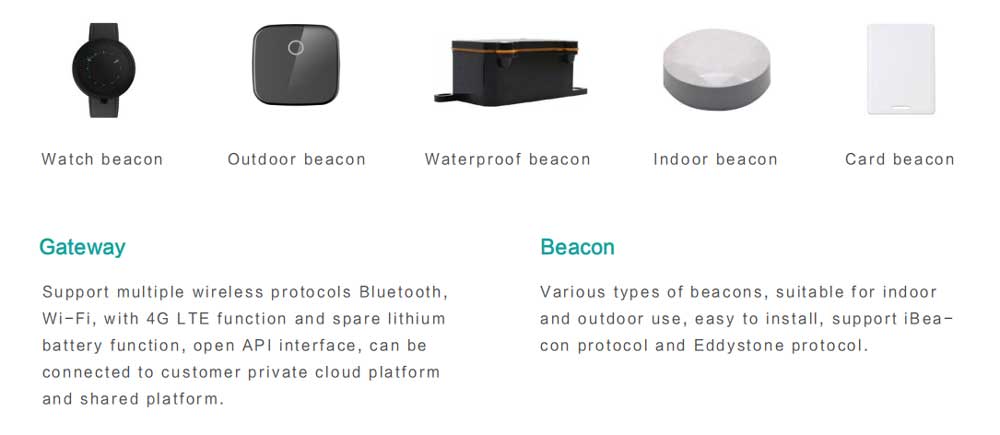
Types of Bluetooth RSSI Positioning Methods
Types of Bluetooth RSSI positioning methods can be categorized into two main approaches: network-side positioning and terminal-side positioning.
In network-side posotioning, as Bluetooth signals travel, they may experience a certain amount of energy attenuation. The farther the distance between the transmitter and receiver, the weaker the signal strength becomes. Therefore, positioning can be accomplished by estimating the distance to the transmitter from the received signal strength.
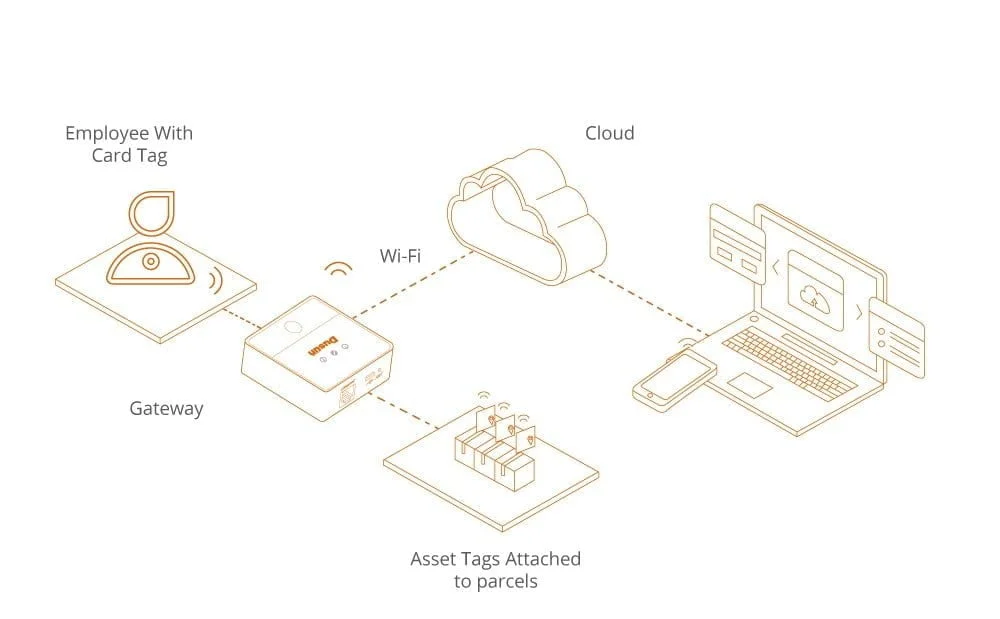
In terminal side positioning, time difference measurement is used for positioning. In this method, the terminal device calculates its own position by receiving timestamps or signal strengths from multiple Bluetooth base stations or beacons. It then calculates the time difference or signal strength difference to determine its location.
No matter which positioning method is chosen, the fundamental requirement is to initially receive the broadcast signal. This received Bluetooth signal forms the basis for assessing the distance from the object being measured.
Terminal-side positioning is generally used for indoor positioning navigation, proximity marketing for shopping malls and other user-terminal-based applications. While network-side positioning is primarily used in situations such as personnel tracking and positioning, asset management and passenger flow analysis.
Bluetooth RSSI Positioning Solutions based on Bluetooth Gateways
This positioning solution is well-suited for deployment in settings such as nursing homes and schools. It is centered around Bluetooth gateways, incorporate low-power, cost-effective, and long-lasting BLE beacons.
We can deploy the Bluetooth gateway on ceilings or walls, where it estimates distances and triangulates positions using Bluetooth RSSI. Additionally, Bluetooth gateway can relay information regarding the beacons’ power status and other pertinent data to the designated locations that require this data.
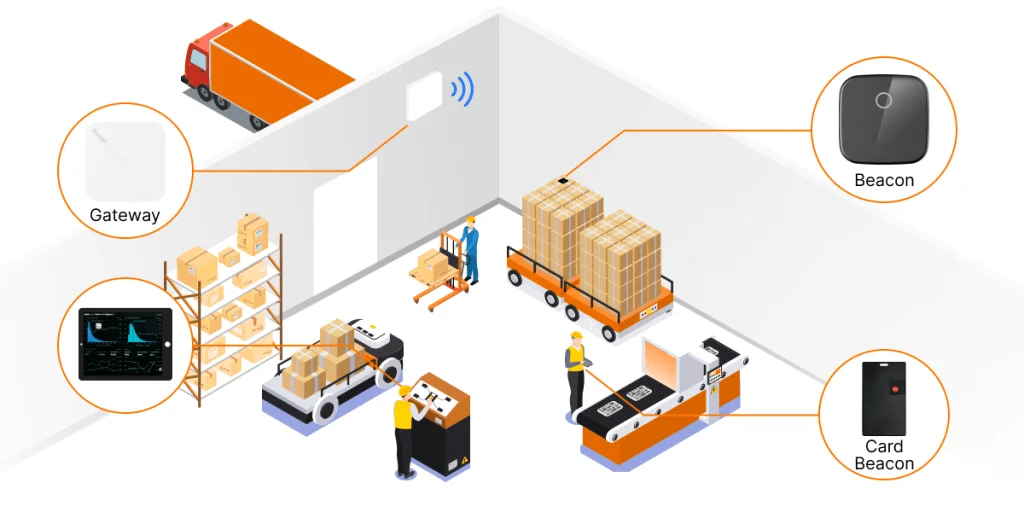
Additionally, there is a reverse positioning method that marks the scanning range of the Bluetooth gateway as a safe area, and at the same time places the Bluetooth beacons on critical assets that need to be monitored. Once the Beacon device leaves the safe range, it can trigger a background security alarm. Achieving the purpose of unknown tracking is also the key to achieving safe care and house management. When a Beacon device moves out of the safe range, it can activate a background security alarm. This method serves the dual purpose of enabling unobtrusive tracking and ensuring the safety of care and property management.
Pros and Cons of Bluetooth RSSI in Real-time Asset Management
For simple short range applications, usually, only one receiver is required. However, to precisely determine an asset’s actual location in asset tracking scenarios, especially in larger or more complex environments and proximity information alone proves insufficient, it becomes necessary to utilize three or more receivers (BLE beacon gateways). This demands trilateration and path loss models for estimating the asset’s relative position to the receivers. At the same time, compared with indoor navigation scenarios, where a few beacons may suffice, three or more Bluetooth beacons are typically needed to accurately locate the receiver.
Typically, in environments like warehouses, there may be more than 10 receivers, increasing the complexity. In this instance, these receivers must relay signal strength data to a server, which then relies on trilateration algorithms to estimate asset locations.
It’s essential to note that RSSI may tell you which room the asset is in, but it cannot pinpoint its specific location inside the room or even its orientation concerning the receiver. For situations demanding high accuracy, directional information, or both, it is advisable to explore the use of BLE 5.1 Angle of Arrival (AoA) technology instead of, or in combination with, RSSI. BLE AoA positioning offers enhanced capabilities for precise location determination and directional insights.
You may also be interested in: UWB vs Bluetooth RSSI vs AoA
If the asset you are tracking is very small and requires higher accuracy for effective location determination, or you are tracking an asset intended for use in emergency situations where low accuracy could pose significant risks, RSSI might not be the best option in this situation, or at least not on its own.
In summary, Bluetooth RSSI offers simplicity and cost-effectiveness for short-range applications, but for precise asset tracking and location determination, it may be more prudent to explore alternative or complementary technologies to enhance location accuracy and reduce the likelihood of inaccuracies.
Working Principle of Bluetooth RSSI Positioning
RSSI, which stands for Received Signal Strength Indication, is a measure of signal power received by a device. When a Bluetooth gateway scans for nearby Bluetooth beacon devices, each beacon device’s Bluetooth radio provides an RSSI measurement for the gateway. RSSI is measured in decibels (dBm) on a logarithmic scale, with negative values indicating greater distance between the devices.
In practical applications, the RSSI values may typically range from -100 to 0 dBm. RSSI values closer to 0 indicate a stronger signal, while more negative values represent weaker signals. An RSSI value of 0 dBm signifies an exceptionally strong signal, but it’s rarely encountered in practice.
We assume that BS1(x1,y1), BS2(x2,y2), and BS3(x3,y3) are three fixed-position Bluetooth beacons that are arranged in a space. The location of the access point (E) can be approximately determined using the three-point positioning principle. This principle involves the concept that the signal from the transmitter spreads out in all directions to form a spherical intersection. By analyzing the intersection of these signal spheres, it becomes possible to calculate the approximate location (x, y) of the access point (E).
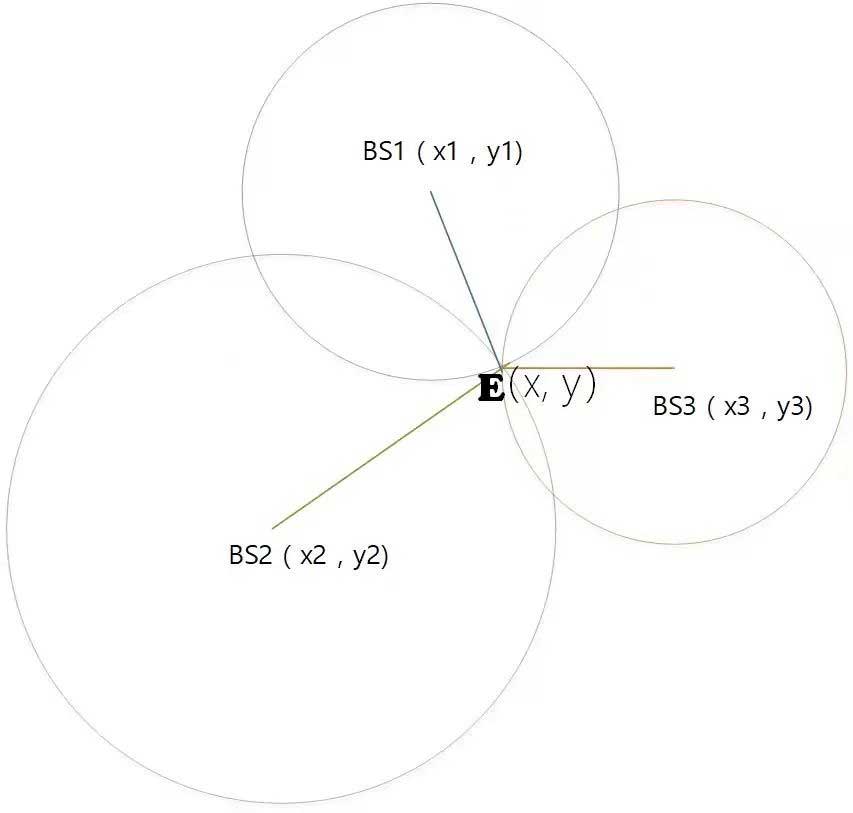
Accuracy of Bluetooth RSSI Positioning
In real-world applications, the Bluetooth signal RSSI positioning algorithm is not that simple as described. The algorithm also incorporates considerations for varying attenuation factors in different environments and applies filtering algorithms to reduce signal interference in order to enhance the stability of the positioning data. In some cases, inertial navigation algorithms are integrated into the process. Despite these enhancements, it’s important to note that the position derived using Bluetooth RSSI is still only a rough estimate.
Why is it described as a rough estimate? Bluetooth RSSI positioning always faces inherent challenges related to signal stability and environmental factors.
- Signal Variability: Even in open environments, Bluetooth broadcast signals can be unstable, and the correlation between signal attenuation and distance is not always clear. At the same location, the received RSSI signal from the same transmitter can exhibit significant variations, sometimes differing by several dBm units, and even exceeding 10dBm. This variability weakens the correlation between the signal attenuation model and distance.
- Signal Behavior in Complex Environments: In less ideal environments with materials like metal, glass, and water that can cause signal diffraction and reflection, signal attenuation might not follow a clear linear path. In some cases, it can even exhibit a negative correlation with distance. This means that as the transmitter gets farther from the receiver, the RSSI signal value received may actually increase, resulting in a significant positioning error. In extreme cases, these factors can lead to positioning errors exceeding 5 meters, highlighting the challenges and approximations involved in Bluetooth RSSI positioning.
Nevertheless, in most cases, the positioning accuracy of Bluetooth typically falls within the range of 2 to 5 meters. When compared to the positioning accuracy of traditional GPS systems, Bluetooth RSSI positioning offers a relatively impressive performance.
Use Cases of Bluetooth RSSI Positioning
When using Bluetooth RSSI for indoor real-time positioning, Bluetooth transmitters (often called positioning beacons) are typically affixed to items that need to be tracked. These beacons continuously transmit their current location and RSSI value to stationary devices strategically placed throughout the facility. A Bluetooth receiver, often referred to as a locator or Bluetooth IoT gateway, collects this information and relays it to a central server. The server, in turn, processes the data and provides relevant updates to the end-users, alerting them to the current location of the tracked items.
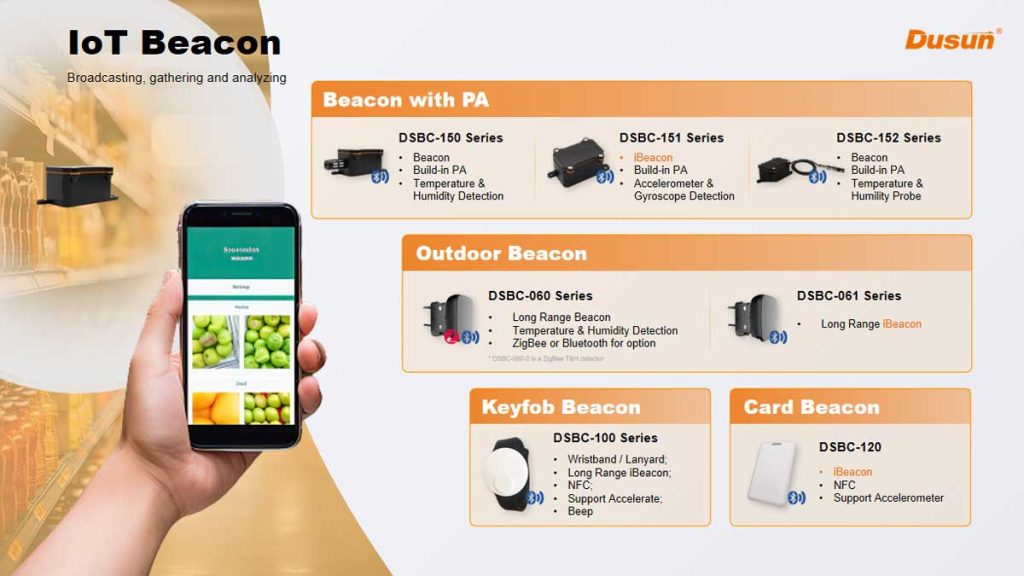
For example, in hospital settings, Bluetooth RSSI-based asset tracking makes the management of critical assets, including valuable and movable medical equipment such as emergency facilities, possible. This smart approach to asset management not only improves productivity, it can also have life-saving implications by reducing the time required to locate essential equipment.
Below, we provide a more in-depth exploration of practical use cases for these Bluetooth RSSI positioning technologies.
Indoor Asset Tracking
Indoor asset tracking is crucial for enhancing efficiency, productivity, and employee safety within large organizations like hospitals and factories. These institutions require systems that can accurately monitor their vital assets. For applications that do not require very precise positioning, the most common solution is to use RSSI, which is a measure of the power level of the Bluetooth signal at the receiver.
Simply put, RSSI data makes it possible to estimate an asset’s approximate position by observing the strength of the received signal. Given that RSSI values are negative, the closer an asset is to the receiver, the closer its RSSI value is to zero.
In the present day, a majority of enterprise-grade WiFi access points are equipped with built-in Bluetooth radios capable of measuring RSSI. As a result, RSSI represents a cost-effective solution for obtaining an approximate asset location, typically offering a measurement accuracy of around five meters. Know more about Bluetooth Access Point here.
If more precise positioning is required, Bluetooth 5.1 direction finding technology is necessary. The angle of arrival (AoA) released in Bluetooth 5.1 enables positioning assets with sub-meter accuracy. To track assets via BLE AoA positioning solution, a Bluetooth transmitter chip must be connected to the asset, consistently transmitting Bluetooth data packets. These packets are then captured by an antenna array of AoA locators, which is often mounted on the ceiling for optimal coverage.
Indoor Navigation
Although the use of GPS for outdoor navigation is very commonly seen, positioning and navigation in large, complex indoor spaces such as hospitals or airports is challenging because these environments typically lack the necessary navigation infrastructure to precisely determine the current location of individuals. However, Bluetooth technology provides several viable solutions for establishing dependable indoor navigation systems.
One approach is to integrate Bluetooth beacon technology into existing infrastructure. Beacons provide continuous radio transmissions that can be discovered by any Bluetooth scanner within the beacon’s radius. For most commercial facilities, one option is to add beacons to existing WiFi access points and gateways.
Another approach involves integrating wireless Bluetooth connection into the lighting system, thereby reducing the cable requirements. Once the beacons are installed, visitors can access indoor floor maps on Bluetooth-enabled devices, like smartphones. This allows for seamless indoor navigation experience similar to outdoor GPS navigation.
Why Choose Dusun IoT’s Bluetooth RSSI Positioning Device?
Dusun IoT’s BLE beacon gateway leverages Silicon Labs’ BLE SoC, known for its compact size, low power consumption, extensive range, and exceptional RF sensitivity. This combination offers an all-in-one solution for creating robust, dependable, and secure Bluetooth RSSI positioning systems.
The BLE modules, built upon Silicon Labs’ EFR32BG21 wireless SoC, excels in performance, energy efficiency, and IoT security. It is particularly well-suited for applications in home automation, healthcare, and industrial settings. For those who prioritize battery life and compact design, Dusun IoT provides Bluetooth modules only slightly larger than a coin. Across the board, Dusun IoT’s Bluetooth gateways and beacons promise an exceptional developer experience. This empowers developers to design forward-thinking products and continuously enhance their product portfolios.
FAQs of Bluetooth RSSI Positioning
What is the difference between RX and RSSI?
The key difference between RX and RSSI lies in how they represent the power level received by an antenna:
- RX (Received Power): RX is typically measured in milliwatts (mW) or decibels-milliwatts (dBm). It provides an absolute measurement of the received power, indicating the actual power level of the received signal.
- RSSI (Received Signal Strength Indication): RSSI, on the other hand, is expressed as a signal strength percentage or a relative measurement. It conveys the relative strength of the received signal, and the higher the RSSI value, the stronger the signal appears to be.
The key distinction is that RX offers an absolute power measurement, while RSSI is relative and specific to the chip manufacturer’s interpretation. There is no standardized relationship between a particular physical parameter and the RSSI reading. However, on some specific platforms, a mapping might exist that links an RSSI value to a particular physical RX value. In certain situations, only RSSI data is accessible from the high-level API, which can be a limitation when precise power measurements are required.
What is the positioning accuracy of Bluetooth positioning?
The positioning accuracy of Bluetooth positioning typically falls within the range of 2 to 5 meters. This accuracy depends on the density of placed positioning beacons, with denser deployments generally resulting in higher positioning accuracy, potentially down to 2 meters. It’s important to clarify that a positioning accuracy of 2 meters does not mean that the difference between the estimated position and the actual location is exactly 2 meters. Achieving smaller positioning accuracies, such as less than 1 meter, is not typically feasible; it is calculated based on probability.
For instance, when referring to a 2-meter positioning accuracy, it means that 95% of the positioning area has an accuracy within 2 meters of the true location to be considered a 2-meter accuracy level. This reflects the probability-based nature of positioning accuracy.
Is there any delay in Bluetooth positioning time?
Yes, there is a delay in Bluetooth positioning time due to several factors in the process. These factors include:
- Scanning and Reporting Interval: The Bluetooth positioning receiver periodically scans for signals and reports data. The time between each scanning cycle introduces a delay in updating the receiver’s information.
- Broadcast Interval of Bluetooth Beacons: Bluetooth beacons transmit their signals at specific intervals. The time between each beacon broadcast affects the positioning process.
- Network Transmission Time: Data collected by the Bluetooth receiver needs to be transmitted to a central server through a network. Network transmission time contributes to the overall delay.
Positioning Algorithm Processing: The calculation and processing of data by the positioning algorithm also take time to determine the location accurately.
In general, the delay from the actual anchor point in Bluetooth positioning is approximately around 3 seconds. This delay can vary based on the specific implementation and the factors mentioned above.
Why does the positioning point fluctuate, or the positioning point jumps around in one position?
The fluctuation or jumping of the positioning point in Bluetooth positioning occurs due to several reasons:
- Signal Variability: The signal received by the positioning receiver is influenced by the distance between the transmitter and receiver. As this distance changes, the received signal strength, measured by RSSI, fluctuates accordingly. This natural variability in signal strength can lead to fluctuations in the estimated positioning point.
- Environmental Interference: Various environmental factors, such as the presence of metal objects, water, glass, or human obstructions, can interfere with the Bluetooth signal. These interferences cause rapid changes in the signal values received by the receiver, further contributing to positioning point fluctuations.
- Interference from Surroundings: Other electronic devices and signals in the surrounding environment can also affect the Bluetooth signals, leading to sudden changes in RSSI values.
- Multipath Propagation: In some cases, signal reflections and multipath propagation can cause signal variations as the waves bounce off objects and arrive at the receiver from different angles.
Under normal circumstances, the fluctuation range of the positioning point is typically within 3 meters. This fluctuation is a common characteristic of Bluetooth positioning and is due to the inherent challenges in accurately estimating positions in complex indoor environments with changing signal conditions.
Will Bluetooth positioning cause interference to other devices?
Bluetooth positioning technology operates within the 2.4GHz wireless frequency band, which is a public frequency band used by various devices, including Wi-Fi in smartphones and other wireless technologies. The key to minimizing interference is that these devices employ different communication mechanisms.
Bluetooth uses Frequency Hopping Spread Spectrum (FHSS) technology, which involves rapidly switching between a set of available frequencies within the 2.4GHz band. This frequency-hopping approach helps Bluetooth devices avoid interference with other devices using continuous-wave signals. Wi-Fi, on the other hand, uses orthogonal frequency division multiplexing (OFDM) technology.
In general, while Bluetooth and other wireless devices share the same frequency band, their different modulation schemes and technologies are designed to coexist without causing significant interference to one another. This allows for the simultaneous operation of various wireless devices in the 2.4GHz band, including those used for Bluetooth positioning, Wi-Fi, and more.
What is the Bluetooth iBeacon protocol?
The iBeacon protocol is a specific implementation of BLE technology, developed by Apple. It defines a standardized format for transmitting data using BLE. The iBeacon protocol helps in creating a consistent and defined structure for the 32 bytes of data transmitted by Bluetooth beacons, making it easier for applications and devices to recognize and interact with these beacons. This standardized format has found use in various location-based and proximity-aware applications.
Can Bluetooth achieve centimeter-level positioning?
Centimeter-level positioning cannot be achieved relying on Bluetooth RSSI, but Bluetooth 5.1 adds a phased antenna to calculate the angle of arrival of the signal, that is, positioning based on Bluetooth AoA. The positioning can reach up to 0.1-0.5 meter average accuracy.
How will Bluetooth RSSI ranging be affected?
Bluetooth RSSI (Received Signal Strength Indication) ranging is influenced by various real-world factors, including co-channel interference, multipath propagation, physical obstructions, the performance and orientation of the antennas, environmental factors like temperature, humidity, and electromagnetic interference, variations in the design and performance of Bluetooth devices and chipsets.
Due to these factors, Bluetooth RSSI ranging can exhibit fluctuations and different trends in different scenarios and environments. This is why RSSI-based positioning often provides approximate location information rather than pinpoint accuracy, especially in complex indoor settings.



















